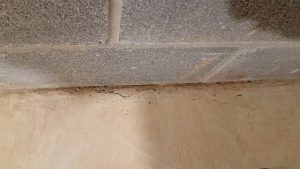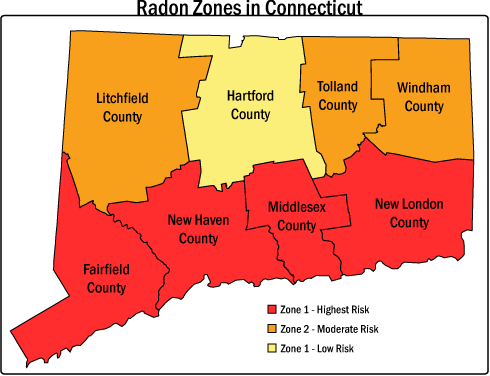What is Radon?
Radon is a naturally occurring carcinogen. This radioactive gas is released from rock, soil and water formed from the breakdown of uranium. The exterior levels in air pose a low threat to human health. However, radon can enter homes from surrounding soil and become a health hazard inside buildings. You can’t see it or smell it, but an elevated radon level in your home may be affecting the health of your family. Our home inspectors can help you to determine if radon is present in your home.
Exposure to radon over prolonged periods may damage lung tissue. Radon gas is the leading cause of lung cancer in nonsmokers in the United States. The U.S. Environmental Protection Agency (EPA) estimates that radon causes more than 20,000 lung cancer deaths in the country each year. It is second only to smoke induced lung cancer. If you smoke and your home has radon, your risk of developing lung cancer can be much higher
Radon has been found in elevated levels in homes in every state. High radon concentrations can occur in all parts of Connecticut. It may not be elevated in every home. Just because your neighbor’s house doesn’t have an elevated level of radon does not mean that your house will also have a low radon level. The only way to know if your home has an elevated radon level above the EPA action level of 4 pCi/L is to have the indoor air of your home tested.  High levels of radon in homes usually come from the surrounding soil or well water that contains radon gas. Radon gas is drawn into a house through foundation cracks and openings, such as sump pump lids and plumbing features. Radon is a heavier gas and tends to be more concentrated on the lower levels of your home. Radon may also be found in your water supply if your home is served by a private well.
High levels of radon in homes usually come from the surrounding soil or well water that contains radon gas. Radon gas is drawn into a house through foundation cracks and openings, such as sump pump lids and plumbing features. Radon is a heavier gas and tends to be more concentrated on the lower levels of your home. Radon may also be found in your water supply if your home is served by a private well.
Radon levels vary throughout the year and tend to be higher in the winter months. The best time to test for radon is in the colder season between the months of November through March when your house is closed.
The amount of radon in the air is measured in “picocuries per liter of
air” or (pCi/L). The US EPA recommends that homes with radon
levels at 4 pCi/L or higher be mitigated to reduce the radon below this level. However, any amount of radon exposure can pose some health risk. Therefore, the EPA recommends that homeowners may want to consider fixing their homes for radon levels between 2 pCi/L and 4 pCi/L. Even if your radon test result is below 4 pCi/L, it is recommended that you have the home tested every 2-5 years or following significant renovations. If your living patterns change and you begin occupying a lower level of your home, such as the basement, you should test on that level. If you are planning a structural renovation, such as converting an unfinished basement area into a living space, it is important to test both before you begin the renovation and after the work is completed. These structural renovations may alter the ventilation of the home and allow radon levels to be more concentrated.
Testing your home is easy to do and should o
nly take a few minutes of your time.  Pondview Inspections can place a radon detector in the basement or on the first floor, and after 2 to 7 day
Pondview Inspections can place a radon detector in the basement or on the first floor, and after 2 to 7 day
s have the results. Pondview Inspections is certified to use specialized equipment that is calibrate annually and provides very accurate results.
Pondview uses CRM( Continuous Radon Monitors) or scintillation vials that can quickly and accurately detect how much radon is present.
If the radon test indicated that your house has elevated levels of radon, you should choose a qualified radon mitigation (reduction) contractor to take steps to reduce the levels to below 4 pCi/L. A mitigation contractor takes steps that may include installing ventilation systems, sealing entry routes for radon gas and installing sub-slab depressurization systems to reduce radon levels. The average cost of a radon mitigation system in Connecticut is approximately $1,500 – $2,500. The price can vary depending on the age and structural limitations of your home.



